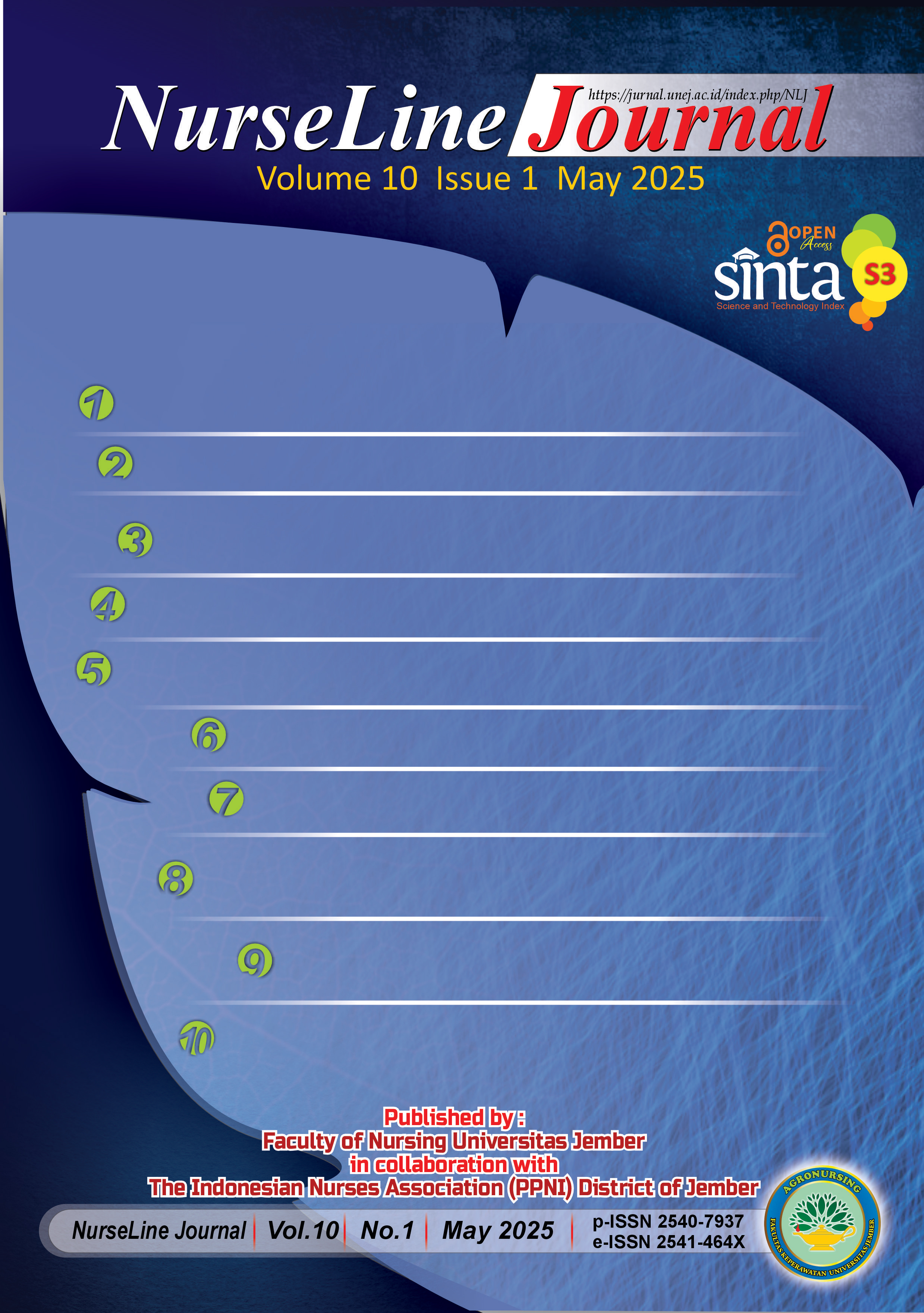The Effectiveness of Thought Stopping Therapy Reducing Anxiety Among Mothers With Under-Five Stunted Children: A Quasi-Experimental Study
DOI:
https://doi.org/10.19184/nlj.v10i1.53691Keywords:
Thought stopping, Anxiety, Mothers with under five stunted childrenAbstract
Background: Children with stunted growth experience impaired development low motor and cognitive abilities. Mothers with stunted children often experience anxiety and fear about their children future regarding their developmental delays and guilt about their children's condition and impact relationship between mother and child. Objective: Study aims to determine effect of thought stopping therapy on anxiety levels of mothers stunted children under five. Methods: A quasi-experiment with a pre-post test and control group design. Purposive sampling technique to obtain a sample comprising 60 mothers, of whom 30 were in the intervention group and 30 were in the control group. The intervention group, maternal anxiety was measured before and after the thought stopping therapy was given. Therapy was given over 3 sessions for 3 days. The control group given deep breathing relaxation techniques to reduce
anxiety. Anxiety levels were measured using HARS. The Wilcoxon and MannWhitney tests analyzed data obtained. Results: There was a significant difference in anxiety levels before and after thought stopping therapy intervention and standard education (p 0.001). Conclusion: Thought stopping therapy is effective in reducing anxiety in mothers of stunted children under five.
Downloads
References
Alam, M. A., Richard, S. A., Fahim, S. M., Mahfuz, M., Nahar, B., Das, S., Shrestha, B., Koshy, B., Mduma, E., Seidman, J. C., Murray-Kolb, L. E., Caulfield, L. E., Lima, A. A. M., Bessong, P., & Ahmed, T. (2020). Erratum: Impact of early-onset persistent stunting on cognitive development at 5 years of age: Results from a multi-country cohort study (PLoS One (2020) 15:1 (e0227839) DOI: 10.1371/journal.pone.0227839). PLoS ONE, 15(2), 1–16. https://doi.org/10.1371/journal.pone.0229663.
Angela Cynthia Maharani, & Najlatun Naqiyah. (2022). Thought stopping techniques to reduce social anxiety. Bisma The Journal of Counseling, 6(2), 249–257. https://doi.org/10.23887/bisma.v6i2.50135.
Christyaningrum, H., Astuti, B., Puri, L. W., & Martono, M. (2022). The Effectiveness of Thought Stopping to Reduce Public Speaking Anxiety for the Students of Counseling Programs. Proceedings of the International Seminar on Innovative and Creative Guidance and Counseling Service (ICGCS 2021), 657(Icgcs 2021), 52–57. https://doi.org/10.2991/assehr.k.220405.010.
Ekholuenetale, M., Barrow, A., Ekholuenetale, C. E., & Tudeme, G. (2020). Impact of stunting on early childhood cognitive development in Benin: Evidence from Demographic and Health Survey. Egyptian Pediatric Association Gazette, 68(1). https://doi.org/10.1186/s43054-020-00043-x.
Giyaningtyas, I. J., Hamid, A. Y. S., & Daulima, N. H. C. (2019). Holistic response of mother as caregiver in treating stunting children. Pakistan Journal of Medical and Health Sciences, 13(3), 928–932.
Giyaningtyas, I. J., Yani, A., & Hamid, S. (2019). The Effect of the Thought Stopping Therapy on Reducing Anxiety Among Mother of Children with Stunting. International Journal of Nursing and Health Services (IJNHS), 2(2), 7.
Hardayati, Y. A., Mustikasari, & Panjaitan, R. U. (2021). The effects of thought stopping on anxiety levels in adolescents living in earthquake-prone areas. Enfermeria Clinica, 31, S395–S399. https://doi.org/10.1016/j.enfcli.2021.01.001.
Kemenkes. (2018). Buletin Jendela Data dan Informasi Kesehatan: Situasi Balita Pendek di Indonesia. Kementerian Kesehatan RI, 20.
Ma, X., Yue, Z. Q., Gong, Z. Q., Zhang, H., Duan, N. Y., Shi, Y. T., Wei, G. X., & Li, Y. F. (2017). The effect of diaphragmatic breathing on attention, negative affect and stress in healthy adults. Frontiers in Psychology, 8(JUN), 1–12. https://doi.org/10.3389/fpsyg.2017.00874
Mustakim, M. R. D., Irwanto, Irawan, R., Irmawati, M., & Setyoboedi, B. (2022). Impact of Stunting on Development of Children between 1-3 Years of Age. Ethiopian Journal of Health Sciences, 32(3), 569–578. https://doi.org/10.4314/ejhs.v32i3.13
Nuss, P. (2015). Anxiety disorders and GABA neurotransmission: A disturbance of modulation. Neuropsychiatric Disease and Treatment, 11, 165–175. https://doi.org/10.2147/NDT.S58841.
Putri, L.T.D., Kartasurya, M.I. & Musthofa, S.B. (2024). Self-Stigma, Experiences and Psychological Conditions of Mothers Having Children with Malnutrition-Stunting: Literature Review. Media Publikasi Promosi Kesehatan Indonesia (MPPKI), 7(7), 1764–1771. https://doi.org/10.56338/mppki.v7i7.5407
Sari, N. Y., Antoro, B., & Alie, M. S. (2020). Effects of Thought Stopping Therapy on Anxiety in the Elderly Facing the Covid 19 Pandemic in Elderly Home. Journal for Quality in Public Health, 4(1), 135–139. https://doi.org/10.30994/jqph.v4i1.128
Saripah, S. (2022). Anak Penderita Stunting dan Psikologis Orang Tua: Kajian di Desa Teluk, Batanghari. JIGC (Journal of Islamic Guidance and Counseling), 6(1), 29–48. http://jigc.dakwah.uinjambi.ac.id/index.php/jigc/article/view/63
Soliman, A., De Sanctis, V., Alaaraj, N., Ahmed, S., Alyafei, F., Hamed, N., & Soliman, N. (2021). Early and long-term consequences of nutritional stunting: From childhood to adulthood. Acta Biomedica, 92(1), 1–12. https://doi.org/10.23750/abm.v92i1.11346
Stuart. (n.d.).
Stuart, G.W. (2007). Buku saku keperawatan jiwa. Jakarta: EGC
Stuart, G.W. (2013). Principles and practice of psychiatric nursing. (10th ed.). St Louis: Mosby Elsevier.
Toussaint, L., Nguyen, Q. A., Roettger, C., Dixon, K., Offenbächer, M., Kohls, N., Hirsch, J., & Sirois, F. (2021). Effectiveness of progressive muscle relaxation, deep breathing, and guided imagery in promoting psychological and physiological states of relaxation. Evidence-Based Complementary and Alternative Medicine, 2021. https://doi.org/10.1155/2021/5924040
Tyas, A. P., & Setyonaluri, D. (2022). Association between Maternal Mental Health and Child Stunting in Indonesia. Kemas, 17(3), 381–388. https://doi.org/10.15294/kemas.v17i3.27813
Utario, Y., Mulyadi, M., & Kartika, L. (2024). Mothers’ Experiences in Caring for Stunted Toddlers: A Qualitative Study. IJNP (Indonesian Journal of Nursing Practices), 8(2), 87–98. https://doi.org/10.18196/ijnp.v8i2.20702
Walker, S. P., Chang, S. M., Wright, A., Osmond, C., & Grantham-mcgregor, S. M. (2015). Early Childhood Stunting Is Associated with Lower Developmental Levels in the Subsequent Generation of Children. The Journal of Community and International Nutrition, 145(4), 823–828. https://doi.org/10.3945/jn.114.200261.childhood
Downloads
Published
Issue
Section
License
Copyright (c) 2025 NurseLine Journal

This work is licensed under a Creative Commons Attribution-ShareAlike 4.0 International License.








